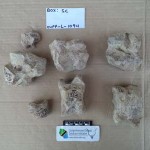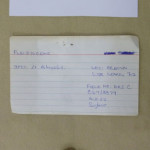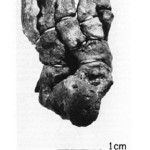 |
OVPP-L-1094 |
10373 |
22 - SC |
|
AST
, POD |
|
126 - Mary Leakey Camp, Antiquities Station Olduvai Gorge, Tanzania |
|
|
|
|
Box: SC. 7 specimens: OLD/71.SC.103, OLD/71.SC.352, OLD/71.SC.480, OLD/71.SC.507, OLD/71.SC.1310, OLD/71.SC.1686, OLD/71.SC.1815 |
|
|
|
Unknown |
|
Mammalia |
|
|
|
|
|
|
|
|
|
|
|
No |
 |
067/3979 DK IC |
8223 |
24 - DK |
|
L-AST |
|
122 - National Museum and House of Culture, Dar es Salaam, Tanzania |
I |
C? |
Surface |
-- |
Left astragulus. Card in bag with specimen states "LOC: OLDUVAI, OLD `62". Pleistocene. |
|
2012/08/03 |
264 - Leakey family expedition |
Unknown |
|
Mammalia |
Primates |
Anthropoidea |
Haplorhini |
Cercopithecoidea |
|
|
|
|
|
|
|
No |
|
OLD-1536 |
13144 |
24 - DK |
|
AST |
|
114 - Natural History Museum UK |
|
S |
|
-- |
OLD-1536; "OLDY DKI S 20.V.35" |
|
|
|
Unknown |
|
Mammalia |
Artiodactyla |
|
|
|
Bovidae |
|
|
|
|
|
|
No |
|
OLD-1542 |
13145 |
27 - MNK |
|
AST |
|
114 - Natural History Museum UK |
II |
|
|
-- |
OLD-1542 |
|
|
|
Unknown |
|
Mammalia |
Artiodactyla |
|
|
|
Bovidae |
|
|
|
|
|
|
No |
 |
OH 8 |
3723 |
6 - FLK NN |
283 - 45 |
PHX
, CAR
, TAR
, CLA
, AST
, CAL
, CUNE
, CUB
, NAV
, M-f |
1960 |
122 - National Museum and House of Culture, Dar es Salaam, Tanzania |
I |
3 |
|
Leakey MD. (1971) Olduvai Gorge, Vol. 3: excavations in Beds I & II 1960-1963. New York, NY: Cambridge University Press. |
The molar-f was found on the surface and "probably also belongs to OH 8" (Leakey MD, 1971:228). Twelve associated foot bones including astragalus (has carnivore tooth marks (Leakey MD, 1971), calcaneus, cuboid and navicular, cuneiforms 1- 3, proximal ends with shafts, five metatarsals. Proximal ends of one metacarpal and three finger phalanges. One radius shaft. Clavicle with damaged articular ends. Foot articulates "almost perfectly with the OH 35 leg" (Susman, 1983:372). |
130 - L.S.B. Leakey |
|
264 - Leakey family expedition |
Yes |
|
Mammalia |
Primates |
Anthropoidea |
Haplorhini |
Hominoidea |
Hominidae |
Homininae |
Hominini |
Homo |
habilis |
|
Paratype |
No |
|
FLK N I 1564 |
1384 |
7 - FLK North |
|
TIB-f, AST, CUBNAV |
1960 |
104 - Unknown |
I |
|
1 |
Gentry, A. W. 1966 Fossil Antilopini of East Africa. Bulletin of the British Museum of Natural History, Geology. 12: 43-106. 9 pls. |
|
137 - A. Gentry |
|
|
Yes |
|
Mammalia |
Artiodactyla |
Ruminantia |
|
Bovoidea |
Bovidae |
Antilopinae |
Antilopini |
Gazella |
|
|
|
No |
|
FLK N I 577 |
1426 |
7 - FLK North |
|
AST |
|
104 - Unknown |
I |
|
1, 2, 3 |
Gentry, A. W. 1966 Fossil Antilopini of East Africa. Bulletin of the British Museum of Natural History, Geology. 12: 43-106. 9 pls. |
|
137 - A. Gentry |
|
|
Yes |
|
Mammalia |
Artiodactyla |
Ruminantia |
|
Bovoidea |
Bovidae |
Antilopinae |
Antilopini |
Gazella |
|
|
|
No |
|
FLK N I 708 |
1427 |
7 - FLK North |
|
AST |
|
104 - Unknown |
I |
|
2, 3 |
Gentry, A. W. 1966 Fossil Antilopini of East Africa. Bulletin of the British Museum of Natural History, Geology. 12: 43-106. 9 pls. |
|
137 - A. Gentry |
|
|
Unknown |
|
Mammalia |
Artiodactyla |
Ruminantia |
|
Bovoidea |
Bovidae |
Antilopinae |
Antilopini |
Gazella |
|
|
|
No |
|
FLK N I Unknown Gazella 1 |
1428 |
7 - FLK North |
|
AST |
|
104 - Unknown |
I |
|
|
Gentry, A. W. 1966 Fossil Antilopini of East Africa. Bulletin of the British Museum of Natural History, Geology. 12: 43-106. 9 pls. |
|
137 - A. Gentry |
|
|
Unknown |
|
Mammalia |
Artiodactyla |
Ruminantia |
|
Bovoidea |
Bovidae |
Antilopinae |
Antilopini |
Gazella |
|
|
|
No |
|
FLK N I Unknown Gazella 2 |
1429 |
7 - FLK North |
|
AST |
|
104 - Unknown |
I |
|
|
Gentry, A. W. 1966 Fossil Antilopini of East Africa. Bulletin of the British Museum of Natural History, Geology. 12: 43-106. 9 pls. |
This specimen is unnumbered. |
137 - A. Gentry |
|
|
Unknown |
|
Mammalia |
Artiodactyla |
Ruminantia |
|
Bovoidea |
Bovidae |
Antilopinae |
Antilopini |
Gazella |
|
|
|
No |
|
FLK N I Unknown Gazella 3 |
1430 |
7 - FLK North |
|
AST |
|
104 - Unknown |
I |
|
1, 2, 3 |
Gentry, A. W. 1966 Fossil Antilopini of East Africa. Bulletin of the British Museum of Natural History, Geology. 12: 43-106. 9 pls. |
Unnumbered astragalus from the "trial trench" at FLK N I. |
137 - A. Gentry |
|
|
Unknown |
|
Mammalia |
Artiodactyla |
Ruminantia |
|
Bovoidea |
Bovidae |
Antilopinae |
Antilopini |
Gazella |
|
|
|
No |
|
FLK N I 6253 |
1555 |
7 - FLK North |
|
AST |
|
104 - Unknown |
I |
3 |
|
Gentry, A. W. 1966 Fossil Antilopini of East Africa. Bulletin of the British Museum of Natural History, Geology. 12: 43-106. 9 pls. |
|
137 - A. Gentry |
|
273 - Reck expedition |
Unknown |
|
Mammalia |
Artiodactyla |
Ruminantia |
|
Bovoidea |
Bovidae |
Antilopinae |
Neotragini |
Phenacotragus |
recki |
|
The author suggests this specimen "may" belong to P. recki. |
No |
|
OVPP-Erinaceus 90 |
2162 |
7 - FLK North |
|
AST, (n=4) |
|
104 - Unknown |
I |
upper |
2, 4 |
Butler, P., and Greenwood, M. 1973. The early Pleistocene hedgehogs from Olduvai, Tanzania. Fossil vertebrates of Africa 3:7-42. |
The authors mention four astragali from layers 2 and 4. |
150 - Butler and Greenwood |
|
|
Unknown |
|
Mammalia |
Insectivora |
|
|
Erinaceoidea |
Erinaceidae |
Erinaceinae |
|
Erinaceus |
broomi |
|
|
No |
|
OVPP-Canis 1 |
3889 |
7 - FLK North |
|
AST, CAL, MTP |
|
|
I |
Zinjanthropus |
3 |
Petter, G. 1973. Carnivores Pleistocenes du ravin d’Olduvai (Tanzanie). Fossil vertebrates of Africa 3:43-100. |
Author does not specify number of each element or whether any of the specimens are from the same individual. |
|
|
|
Unknown |
|
Mammalia |
Carnivora |
Caniformia |
Cynoidea |
|
Canidae |
|
|
Canis |
mesomelas |
latirostris |
|
No |
|
OVPP-Mammalia |
3801 |
83 - FLK NW |
|
AST, (n=33), CAL, (n=73), FEM, (n=272), HUM, (n=186), I, (n=316), M, (n=108), MAN, (n=161), MAX, (n=68), MTP, (n=257), PHX, (n=77), PVG, (n=218), RAD, (n=55), SCP, (n=40), TIB, (n=395), ULNA, (n=76), VER, (n=595) |
|
|
I |
20 |
|
Arcos, S., Sevilla, P., and Fernandez-Jalvo, Y. 2010. Preliminary small mammal taphonomy of FLK NW level 20 (Olduvai Gorge, Tanzania). Quarternary Research 74:405-410. |
MNI is 198. Authors describe specimens as "small mammals". |
|
|
|
Unknown |
|
Mammalia |
|
|
|
|
|
|
|
|
� |
|
Authors describe specimens as "small mammals". |
No |


